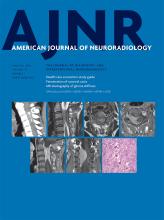Index by author
Kinner, S.
- FELLOWS' JOURNAL CLUBPediatric NeuroimagingYou have accessDeep Brain Nuclei T1 Shortening after Gadobenate Dimeglumine in Children: Influence of Radiation and ChemotherapyS. Kinner, T.B. Schubert, R.J. Bruce, S.L. Rebsamen, C.A. Diamond, S.B. Reeder and H.A. RowleyAmerican Journal of Neuroradiology January 2018, 39 (1) 24-30; DOI: https://doi.org/10.3174/ajnr.A5453
The authors reviewed clinical charts and images of patients 18 years of age or younger with ≥4 gadobenatedimeglumine–enhanced MRIs for 6 years. Seventy-six children (60 unconfounded by treatment, 16 with radiochemotherapy) met the selection criteria. T1 signal intensity ratios for the dentate to pons and globus pallidus to thalamus were calculated and correlated with number of injections, time interval, and therapy. Among the 60 children without radiochemotherapy, only 2 had elevated T1 signal intensity ratios. Twelve of the 16 children with radiochemotherapy showed elevated signal intensity ratios. Statistical analysis demonstrated a significant signal intensity ratio change for the number of injections. Compared with published adult series, children show a similar pattern of T1 hyperintense signal changes of the dentate and globus pallidus after multiple gadobenatedimeglumine injections. The T1 signal changes in children are accelerated by radiochemotherapy.
Krawiecki, J.
- Extracranial VascularOpen AccessLower Arterial Cross-Sectional Area of Carotid and Vertebral Arteries and Higher Frequency of Secondary Neck Vessels Are Associated with Multiple SclerosisP. Belov, D. Jakimovski, J. Krawiecki, C. Magnano, J. Hagemeier, L. Pelizzari, B. Weinstock-Guttman and R. ZivadinovAmerican Journal of Neuroradiology January 2018, 39 (1) 123-130; DOI: https://doi.org/10.3174/ajnr.A5469
Krings, T.
- InterventionalOpen AccessTime for a Time Window Extension: Insights from Late Presenters in the ESCAPE TrialJ.W. Evans, B.R. Graham, P. Pordeli, F.S. Al-Ajlan, R. Willinsky, W.J. Montanera, J.L. Rempel, A. Shuaib, P. Brennan, D. Williams, D. Roy, A.Y. Poppe, T.G. Jovin, T. Devlin, B.W. Baxter, T. Krings, F.L. Silver, D.F. Frei, C. Fanale, D. Tampieri, J. Teitelbaum, D. Iancu, J. Shankar, P.A. Barber, A.M. Demchuk, M. Goyal, M.D. Hill and B.K. Menon for the ESCAPE Trial InvestigatorsAmerican Journal of Neuroradiology January 2018, 39 (1) 102-106; DOI: https://doi.org/10.3174/ajnr.A5462
Lai, L.
- Extracranial VascularYou have accessCT Attenuation Analysis of Carotid Intraplaque HemorrhageL. Saba, M. Francone, P.P. Bassareo, L. Lai, R. Sanfilippo, R. Montisci, J.S. Suri, C.N. De Cecco and G. FaaAmerican Journal of Neuroradiology January 2018, 39 (1) 131-137; DOI: https://doi.org/10.3174/ajnr.A5461
Lake, D.S.
- EDITOR'S CHOICEAdult BrainOpen AccessMR Elastography Analysis of Glioma Stiffness and IDH1-Mutation StatusK.M. Pepin, K.P. McGee, A. Arani, D.S. Lake, K.J. Glaser, A. Manduca, I.F. Parney, R.L. Ehman and J. HustonAmerican Journal of Neuroradiology January 2018, 39 (1) 31-36; DOI: https://doi.org/10.3174/ajnr.A5415
Tumor stiffness properties were prospectively quantified in 18 patients with histologically proved gliomas using MR elastography. Images were acquired on a 3T MR imaging unit with a vibration frequency of 60 Hz. Tumor stiffness was compared with unaffected contralateral white matter, across tumor grade, and by IDH1-mutation status. Gliomas were softer than healthy brain parenchyma, 2.2kPa compared with 3.3kPa, with grade IV tumors softer than grade II. MR elastography demonstrated that not only were gliomas softer than normal brain but the degree of softening was directly correlated with tumor grade and IDH1-mutation status.
Larrabide, I.
- InterventionalOpen AccessHemodynamic Changes Caused by Multiple Stenting in Vertebral Artery Fusiform Aneurysms: A Patient-Specific Computational Fluid Dynamics StudyN. Lv, W. Cao, I. Larrabide, C. Karmonik, D. Zhu, J. Liu, Q. Huang and Y. FangAmerican Journal of Neuroradiology January 2018, 39 (1) 118-122; DOI: https://doi.org/10.3174/ajnr.A5452
Laveskog, A.
- Adult BrainOpen AccessPerivascular Spaces in Old Age: Assessment, Distribution, and Correlation with White Matter HyperintensitiesA. Laveskog, R. Wang, L. Bronge, L.-O. Wahlund and C. QiuAmerican Journal of Neuroradiology January 2018, 39 (1) 70-76; DOI: https://doi.org/10.3174/ajnr.A5455
Lee, J.H.
- Head and Neck ImagingYou have accessEffect of an Arm Traction Device on Image Quality and Radiation Exposure during Neck CT: A Prospective StudyY.J. Choi, J.H. Lee, D.H. Yoon, H.J. Kim, K.J. Seo, K.-H. Do and J.H. BaekAmerican Journal of Neuroradiology January 2018, 39 (1) 151-155; DOI: https://doi.org/10.3174/ajnr.A5418
Lee, L.
- Adult BrainOpen AccessSpatial Correlation of Pathology and Perfusion Changes within the Cortex and White Matter in Multiple SclerosisA.D. Mulholland, R. Vitorino, S.-P. Hojjat, A.Y. Ma, L. Zhang, L. Lee, T.J. Carroll, C.G. Cantrell, C.R. Figley and R.I. AvivAmerican Journal of Neuroradiology January 2018, 39 (1) 91-96; DOI: https://doi.org/10.3174/ajnr.A5410
Lee, S.-K.
- Adult BrainYou have accessPrediction of IDH1-Mutation and 1p/19q-Codeletion Status Using Preoperative MR Imaging Phenotypes in Lower Grade GliomasY.W. Park, K. Han, S.S. Ahn, S. Bae, Y.S. Choi, J.H. Chang, S.H. Kim, S.-G. Kang and S.-K. LeeAmerican Journal of Neuroradiology January 2018, 39 (1) 37-42; DOI: https://doi.org/10.3174/ajnr.A5421








